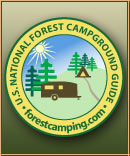Grassland Information
The Black Kettle National Grassland (NG), 31,000 acres, is
located in western Oklahoma with a small portion on the eastern
panhandle side of Texas. It is administered by the Cibola
National Forest. There are four campgrounds three of which meet
the selection criteria.
The Black Kettle National Grassland provides a variety of
recreational opportunities for western Oklahoma and the panhandle
of Texas. Camping, boating, hiking, horseback riding, fishing,
hunting, photography, just to name of few, are some of the
opportunities awaiting visitors to this national grassland. The
land also has a rich Native American, westward expansion, and
Great Depression history.
It is challenging to imagine the Black Kettle NG as anything
other then what it is today but it wasn't always as you see. The
area now designated "grassland" was settled in the 1800s under a
variety of "Homestead Acts," which opened the land to people,
generally farmers, and helped to settle the west. A prolonged
period of drought in the late 1920s into the 1930s caused some
homesteads on this sub-marginal farmland (a location receiving 15
or less inches of annual moisture) to literally dry up and blow
away. During this time, Congress established the Land
Utilization Program (LUP) which bought homesteads from bankrupt
private owners and returned it to public land status. The Work
Program Administration (WPA) and Civilian Conservation Corps
(CCC) enrollees helped to stabilize the eroding soil by planting
trees and sowing native grasses. They also built several of the
lakes on the Black Kettle NG. In the 1950s, the LUP holdings
were assigned to the USDA Forest Service and they were tasked
with management of these sub-marginal lands. Over the years the
Forest Service established some twenty National Grasslands from
those lands. "The designation of an area as National Grassland is
not a description of the area as much as a statement of policy
and effort to restore the area to multiple uses and benefits."
At the Black Kettle Recreation Area, just north of Cheyenne, OK,
visitors can hike, fish, boat, picnic, or just relax. Visitors
have two choices for camping areas. One option is along the
shoreline of the Dead Warrior, a.k.a. Dead Indian, Reservoir
where campsites are in full sun and offer immediate access to the
lake. The other option offers lots of shade in camp sites below
the dam among mature Black walnut. For campers looking for
electric and water hookups and not interested in camping on
water, there is Old Military Road campground in the Lake Marvin
Recreation Area near Canadian, TX. Skipout campground, back in
Oklahoma, is near the little community of Reydon. It is small
and could accommodate a couple of recreational vehicles but is
more for tent campers and offers a boat ramp, fishing, and some
hiking.
Undeveloped sections of the NG are open for exploration by foot
or horse. Here, nature watching and photography opportunities are
plentiful and diverse. The grassland is home to deer, turkey,
beavers, bald eagles, and Monarch butterflies. Parts of it is
open for hunting and is popular with Bobwhite quail, Rio Grande
turkey, and deer hunters (contact the Black Kettle NG for
details). The grassland is also host to two commercial
endeavors, gas and oil drilling and cattle ranching. Special
permits or leases are issued for this commercial use of the land.
Northwest of Cheyenne, OK are the Antelope Hills. The
significance of these hills is they were once called Boundary
Mountains and marked the 100th Meridian. They initially
separated the United States and Spain, and later Mexico, until
1845 when the area became part of the "Indian Territory" and the
Cheyenne-Arapaho Reservation. In 1892, the area was opened to
settlement by whites in a "Land Run." Literally, this meant
settlers ran either on foot, horseback, or wagon to claim160-acre
tracts of designated land.
The Cheyenne and Arapaho people considered the area today called
Black Kettle National Grassland as part of their homeland. Chief
Black Kettle, of the Southern Cheyenne, was killed during a
sunrise attack on his village by the troopers of Lt. Col. George
Armstrong Custer's 7th U.S. Cavalry, just south of the Antelope
Hills and is the source of the name for this national grassland.
A day trip to the Washita Battlefield National Historic Site
provides insight to both the battle, the Cheyenne People's
homeland, and a way of life for Native People.
The area where the Black Kettle NG is located has long been
thought of as remote and it still is. There are no interstate
highways nearby, no outstanding natural wonders within miles and
miles and no large population centers within 150 miles. What
Black Kettle NG does have is a wonderful variety of recreational
opportunities, some special populations of wildlife, and lots of
quiet space - all waiting to be discovered.
ADDRESSES
SUPERVISOR ADDRESS
2113 Osuna Road, NE
Suite A
Albuquerque, New Mexico 87113
505-346-3900
RANGER DISTRICT ADDRESS
Black Kettle
18555 Hwy 47A Suite B
Cheyenne, Oklahoma 73628
580-497-2143
|
